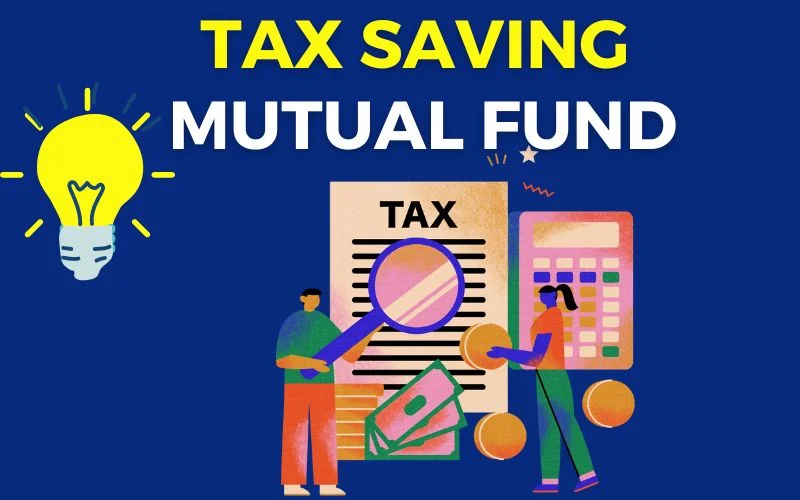Tax saving mutual fund, also known as ELSS (Equity Linked Savings Scheme), is a type of mutual fund investment that falls under section 80C of the Income Tax Act, 1961, and can help you save taxes while also earning potentially higher returns. ELSS is structured to invest most of its assets in equity shares of large-cap companies, which allows investors the potential for capital appreciation. Hence, ELSS falls under the equity mutual funds category.

What is Tax Saving Mutual Fund?
Tax saving mutual fund or ELSS are mutual fund schemes that provide tax benefits under section 80C of the Income Tax Act, 1961. Investments made in these schemes are eligible for tax deductions up to Rs. 1.5 lakh per financial year.
Features of Tax Saving Mutual Fund:
- Lock-in Period: Tax Saving Mutual Fund has a mandatory lock-in period of three years which means that the investments made in these schemes can only be redeemed or withdrawn after three years from the investment date.
- Tax Benefits: Investments made in these schemes are eligible for tax deductions under section 80C of the Income Tax Act, 1961. The amount invested in ELSS can be claimed as a deduction from the total taxable income up to Rs. 1.5 lakh per financial year.
- Risk and Return: ELSS invests in equity shares of companies that are risky by nature compared to debt instruments. The returns in ELSS, therefore, are potentially higher than other tax-saving investment options like fixed deposits, PPF, NSC, and so on.
- SIP Investment: You can invest in a tax-saving mutual fund through Systematic Investment Plan (SIP). An investor can choose to invest a fixed amount every month, which will help them to accumulate wealth over time. If you start a SIP in ELSS, then each SIP transaction gets locked for three years. Hence, you must be careful and plan your SIPs in ELSS so they can be allocated for long-term goals beyond 6 years.
- Example: Suppose your 1st SIP installment in ELSS started in 1st-April-2022; then the first installment can be redeemed /withdrawn only on 1st April 2025, the 2nd installment on 1st -May-2025, and so on. If you wish to withdraw the entire fund invested via SIP in ELSS at one short, it can be done only after completing 3 years of the last SIP.
Benefits of Tax Saving Mutual Fund:
- Tax Saving: ELSS provides tax benefits to the investor. Investments made in these schemes are eligible for tax deductions under section 80C of the Income Tax Act 1961.
- Capital Appreciation: ELSS invests in equity shares of companies, providing the potential for capital appreciation with higher risk.
- Diversification: ELSS invests in equity shares of companies across sectors and categories, providing diversification benefits to the investor; this reduces the risk of investment in a single sector.
- SIP Investment: Tax Saving Mutual Fund can be invested through Systematic Investment Plan (SIP). An investor can choose to invest a fixed amount every month, which will help them to accumulate wealth over time.
- Long-term Investment: ELSS has a mandatory lock-in period of three years, which encourages long-term investment in equities. Long-term investment helps in generating higher returns and also reduces the risk of investment.
Disadvantages of Tax Saving Mutual Fund:
- Lock-in Period: ELSS (Equity Linked Savings Scheme) has three years of the mandatory lock-in period, meaning that the investments made in these schemes can only be redeemed or withdrawn after three years from the investment date. However, if you see otherwise, then more than a disadvantage, it is an advantage as three years lock-in period is the shortest lock-in period for tax savings instruments. Other tax savings instruments have a lock-in period of a minimum of 5 years (tax savings FD), even up to 21 years (SSY).
- Market Risk: ELSS invests in equity shares of companies that carry market risk. The returns are, therefore, not guaranteed, and investors need to be ready for fluctuations in the value of their investments.
- No Fixed Returns: Unlike fixed deposits or other tax-saving investment options, ELSS does not provide fixed returns. The returns are market-linked and are subject to fluctuations.
- High Risk: ELSS invests in equity shares of companies with higher risk than debt instruments.
List and Performance of Tax Saving Mutual Fund
Source: AMFI
How do Tax Saving Mutual Funds work?
Tax saving mutual fund invest in equity to generate long-term capital appreciation for the investors. These funds have a three-year lock-in period, meaning that investors cannot redeem their units before this period. However, after the lock-in period, investors can withdraw the units at the fund’s prevailing Net Asset Value (NAV).
ELSS falls under tax saving investment option t under Section 80C of the Income Tax Act, and the maximum amount of Rs. 1.5 lakhs per financial year can be claimed as a deduction under this section. Investors can claim this deduction by investing in ELSS funds.
Investors can invest in ELSS funds in two ways, a lump sum investment and a Systematic Investment Plan (SIP). In a SIP, investors can invest small amounts regularly for a set period; this will help in inculcating a disciplined approach to investing and also helps in averaging out the cost of investment.
Points to Consider Before Investing in Tax Saving Mutual Fund
Before investing in tax saving mutual fund, investors should consider the following factors:
Investment Horizon: ELSS funds are ideal for investors with a long-term investment horizon of at least 3-5 years; this is because equity investments are volatile in the short term and can be impacted by various macroeconomic and microeconomic factors. Therefore, investors should be ready to hold their investments for the long term to ride out any short-term volatility.
Risk Appetite: ELSS funds invest primarily in equity and equity-related instruments, which are inherently more volatile than other asset classes like debt. Therefore, investors should have a high-risk appetite and be prepared to withstand short-term fluctuations in the value of their investments. To understand the risk involved in ELSS, an investor must check the Beta of the fund and compare it with the Beta of the benchmark. One must consider choosing a fund with a low beta that will help the investor with downside protection to some extent.
Fund Performance: Before investing in an ELSS fund, understand the fund performance of the scheme. To understand the fund performance, one must check the alpha of the scheme, which will help you to understand how much excess returns you can expect relative to the benchmark for a given amount of risk taken by the scheme.
Conclusion
ELSS is a good option for tax savings if you are looking for the shortest lock-in and your risk appetite allows it. However, it is always suggested when investing in ELSS or any equity fund that you must be ready to hold for a minimum of 5 years or more, depending upon the type of the mutual fund.
Important Articles related to Personal Finance
- Income Tax New Regime Or Old Regime: For Salaried Employees
- Money management tips for beginners
- Tax Planning For Salaried Employees
- Investment Planning For Salaried Employees
- Mutual Fund KYC Online Registration
- How To Invest In Direct Mutual Funds?
- How To Start SIP Investment In Mutual Funds?
- 5 Mutual Fund Types: Learn To Choose The Right Fund For You

Important Calculators
Frequently Asked Questions
Q-1: What is Tax Saving Mutual Fund?
Tax saving mutual fund or ELSS are mutual fund schemes that provide tax benefits under section 80C of the Income Tax Act, 1961. Investments made in these schemes are eligible for tax deductions up to Rs. 1.5 lakh per financial year.
Q-2: Who should invest in Tax Saving Mutual Fund?
Tax Saving Mutual Fund / ELSS is a good option for tax savings for individuals looking for the shortest lock-in period but willing to hold the investments minimum for 5 years to grab the growth potential of equity investment and whose risk appetite allows them to take the risk.





